| Part of the Politics series |
| Politics |
|---|
| |
The term federalist describes several political beliefs around the world. It may also refer to the concept of parties, whose members or supporters call themselves Federalists. [1]
| Part of the Politics series |
| Politics |
|---|
| |
The term federalist describes several political beliefs around the world. It may also refer to the concept of parties, whose members or supporters call themselves Federalists. [1]
In Europe, proponents of deeper European integration are sometimes called Federalists. A major European NGO and advocacy group campaigning for such a political union is the Union of European Federalists. Movements towards a peacefully unified European state have existed since the 1920s, notably the Paneuropean Union. A pan-European party with representation in the European Parliament fighting for the same cause is Volt Europa.
In the European Parliament the Spinelli Group brings together MEPs from different political groups to work together of ideas and projects of European federalism; taking their name from Italian politician and MEP Altiero Spinelli, who himself was a major proponent of European federalism, also meeting with fellow deputies in the Crocodile Club.
Notable European Federalists are former European Commission president Jean-Claude Juncker, current EC president Ursula von der Leyen, leader of ALDE group Guy Verhofstadt, German Federal Minister for Economic Affairs and Energy of Germany Peter Altmaier, German MEP Elmar Brok and the former leader of the SPD Martin Schulz.
In the Spanish-speaking parts of Latin America the term "federalist" is used in reference to the politics of 19th-century Argentina and Colombia. The Federalists opposed the Unitarians in Argentina and the Centralists in Colombia through the 19th century. Federalists fought for complete self-government and full provincial autonomy, as opposed to the centralized government that the Unitarians and Centralists favored. Furthermore, Federalists demanded tariff protection for their industries and, in Argentina, called for the end of the Buenos Aires customs as the only intermediary for foreign trade. During the Federal War (1859-1863) in Venezuela, liberal caudillos confronted conservatives, leading to the establishment of the modern federal States of Venezuela.
The one Federalist leader in the Platine Region was José Gervasio Artigas, who opposed the centralist governments in Buenos Aires that followed the May Revolution, and created instead the Federal League in 1814 among several Argentine Provinces and the Banda Oriental (modern-day Uruguay). In 1819, the Federal armies rejected the centralist Constitution of the United Provinces of South America and defeated the forces of Supreme Director José Rondeau at the 1820 Battle of Cepeda, effectively ending the central government and securing Provinces' sovereignty through a series of inter-Provincial pacts (v.g. Treaty of Pilar , Treaty of Benegas , Quadrilateral Treaty ). A new National Constitution was proposed only in 1826, during the Presidency of Unitarian Bernardino Rivadavia, but it was again rejected by the Provinces, leading to the dissolution of the National Government the following year.
Federalist Buenos Aires Governor Manuel Dorrego took over the management of the foreign affairs of the United Provinces, but he was deposed and executed in 1828 by Unitarian General Juan Lavalle, who commanded troops dissatisfied with the negotiations that ended the War with Brazil. The following year, Juan Manuel de Rosas, leader of Buenos Aires Federalists, defeated Lavalle and secured his resignation. Rosas was elected Governor of Buenos Aires later that year by the Provincial Legislature. To counteract these developments, the Unitarian League was created by General José María Paz in 1830, uniting nine Argentine Provinces. The 1831 Federal Pact between Buenos Aires, Entre Ríos and Santa Fe Provinces opposed a military alliance to the League and ultimately defeated it during 1832, its former members joining the Federal Pact into a loose confederation of Provinces known as the Argentine Confederation. Although the Unitarians were exiled in neighboring countries, the Civil War continued for two decades.
Buenos Aires Governor Juan Manuel de Rosas exerted a growing hegemony over the rest of the country during his 1835-1852 Government and resisted several Unitarian uprisings, but was finally defeated in 1852 by a coalition Army gathered by Entre Ríos Federalist Governor Justo José de Urquiza, who accused Rosas of not complying with Federal Pact provisions for a National Constitution. In 1853, a Federal Constitution was enacted (the current Constitution of Argentina, through amendments) and Urquiza was elected President of the Argentine Confederation. However, on the aftermath of 1852 Battle of Caseros, the Province of Buenos Aires had seceded from the Confederation. In 1859, after the Battle of Cepeda the State of Buenos Aires rejoined the Confederation, although it was granted the right to make some amendments to its Constitution. Finally, after the 1861 Battle of Pavón, Buenos Aires took over the Confederation.
The following federal governments fought the weaker Federalist and Autonomist resistances in the countryside until the 1870s. The last Autonomist rebellion in Buenos Aires was quelled in 1880, leading to the federalization of Buenos Aires city and the stabilization of the Argentine State and government through the National Autonomist Party.
Federalism, in regard to the National Question, refers to support for Quebec remaining within Canada, while either keeping the status quo or pursuing greater autonomy and constitutional recognition of a Quebec nation, with corresponding rights and powers for Quebec within the Canadian federation. This ideology is opposed to Quebec sovereigntism, proponents of Quebec independence, most often (but not for all followers) along with an economic union with Canada similar to the European Union.
In the United States the term federalist usually applies to a member of one of the following groups:
The Federalist Society for Law and Public Policy Studies is an organization of conservative and libertarian lawyers and others dedicated to debate of these principles.
The World Federalist Movement is a global citizens movement that advocates for strengthened and democratic world institutions subjected to the federalist principles of subsidiarity, solidarity and democracy. It states that "[w]orld federalists support the creation of democratic global structures accountable to the citizens of the world and call for the division of international authority among separate agencies".

The Argentine Confederation was the last predecessor state of modern Argentina; its name is still one of the official names of the country according to the Argentine Constitution, Article 35. It was the name of the country from 1831 to 1852, when the provinces were organized as a confederation without a head of state. The governor of Buenos Aires Province managed foreign relations during this time. Under his rule, the Argentine Confederation resisted attacks by Brazil, Bolivia, Uruguay, France and the United Kingdom, as well as other Argentine factions during the Argentine Civil Wars.
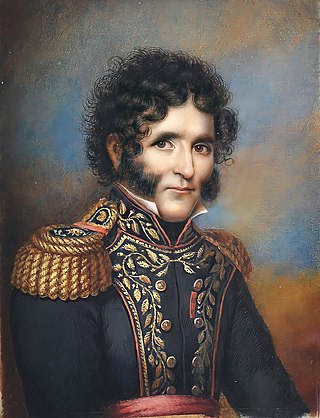
Juan Facundo Quiroga was an Argentine caudillo who supported federalism at the time when the country was still in formation.
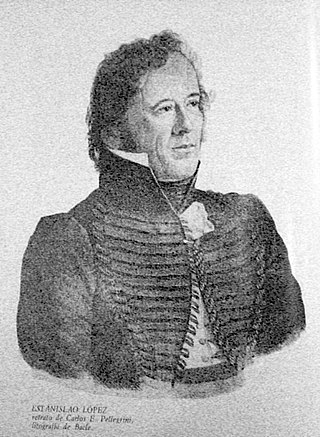
Estanislao López was a caudillo and governor of the province of Santa Fe, Argentina, between 1818 and 1838, one of the foremost proponents of provincial federalism, and an associate of Juan Manuel de Rosas during the Argentine Civil War. He is considered an iconic figure in Santa Fe and one of the most influential political actors in the Argentine conflicts of the 1820s and 1830s.

Manuel Dorrego was an Argentine statesman and soldier. He was governor of Buenos Aires in 1820, and then again from 1827 to 1828.
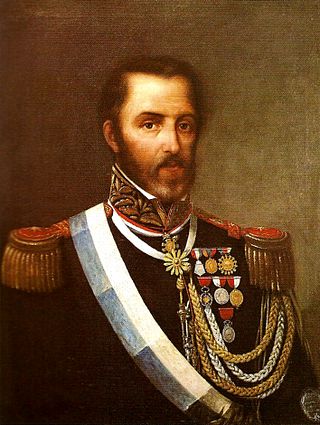
Juan Galo Lavalle was an Argentine military and political figure, from the Unitarian Party.

Unitarianists or Unitarians were the proponents of the concept of a unitary state in Buenos Aires during the civil wars that shortly followed the Declaration of Independence of Argentina in 1816. They were opposed to the Argentine Federalists, who wanted a federation of autonomous provinces. Argentine unitarianism was an ideologic grouping, not a religious one. As such, it is unrelated to religious Unitarianism.

The Federalist Party was the nineteenth century Argentine political party that supported federalism. It opposed the Unitarian Party that claimed a centralised government of Buenos Aires Province, with no participation of the other provinces of the custom taxes benefits of the Buenos Aires port. The federales supported the autonomy of the provincial governments and the distribution of external commerce taxes among the provinces.

Brigadier General José María Paz y Haedo was an Argentine military figure, notable in the Argentine War of Independence and the Argentine Civil Wars.
The Battle of Cepeda of 1820 took place on February 1 in Cañada de Cepeda, Buenos Aires Province, Argentina. The conflict was the first major battle that saw Unitarians and Federals as two constituted sides. It ended with the defeat of the national government.
The Battle of Cepeda of 1859 took place on October 23 at Cañada de Cepeda, Buenos Aires Province, Argentina. The Argentine Confederation army, led by federalist Justo José de Urquiza defeated the State of Buenos Aires forces, led by unitarian Bartolomé Mitre.

The Battle of Pavón, a key battle of the Argentine Civil Wars, was fought in Pavón, Santa Fé Province, Argentina on 17 September 1861 between the Army of the State of Buenos Aires and the Army of Republic of the Argentine Confederation. The withdrawal of Urquiza left the field to Mitre.

Carlos Tejedor was an Argentine jurist and politician, Governor of Buenos Aires Province between 1878 and 1880. Tejedor was a prominent figure in the movement against the Federalization of Buenos Aires.
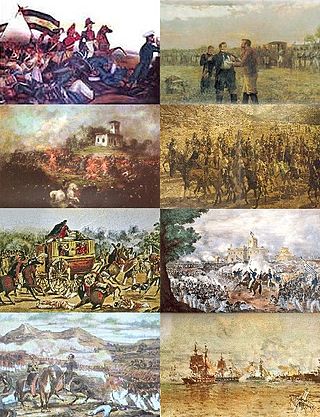
The Argentine Civil Wars were a series of civil conflicts of varying intensity that took place through the territories of Argentina from 1814 to 1853. Beginning concurrently with the Argentine War of Independence (1810–1818), the conflict prevented the formation of a stable governing body until the signing of the Argentine Constitution of 1853, followed by low-frequency skirmishes that ended with the Federalization of Buenos Aires. The period saw heavy intervention from the Brazilian Empire that fought against state and provinces in multiple wars. Breakaway nations, former territories of the viceroyalty, such as the Banda Oriental, Paraguay and the Upper Peru were involved to varying degrees. Foreign powers such as the British and French empires put heavy pressure on the fledgling nations at times of international war.
The Battle of Márquez Bridge, fought on 26 April 1829, during the civil war between Unitarians and Federalists, resulting in a victory for the Federal Party forces of Juan Manuel de Rosas and the governor of Santa Fe Province, Estanislao López, over general Juan Lavalle, who had usurped the office of Governor of Buenos Aires Province.
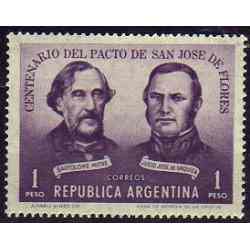
The Pact of San José de Flores was a treaty signed between the Argentine Confederation and the State of Buenos Aires on November 11, 1859, on the aftermath of the Battle of Cepeda. It established guidelines for the entry of the latter into the Confederation, and Buenos Aires' acceptance of the Argentine Constitution of 1853.

Ángel Vicente "Chacho" Peñaloza was a military officer and provincial leader prominent in both the history of La Rioja province and the Argentine civil wars that preceded national unity.

The State of Buenos Aires was a secessionist republic resulting from the overthrow of the Argentine Confederation government in the Province of Buenos Aires on September 11, 1852. The State of Buenos Aires was never recognized by the Confederation; it remained, however, independent under its own government and constitution. Buenos Aires rejoined the Argentine Confederation after the former's victory at the Battle of Pavón in 1861.
The rise of the Argentine Republic was a process that took place in the first half of the 19th century in Argentina. The Republic has its origins on the territory of the Viceroyalty of the Río de la Plata, a colony of the Spanish Empire. The King of Spain appointed a viceroy to oversee the governance of the colony. The 1810 May Revolution staged a coup d'état and deposed the viceroy and, along with the Argentine war of independence, started a process of rupture with the Spanish monarchy with the creation of an independent republican state. All proposals to organize a local monarchy failed, and no local monarch was ever crowned.
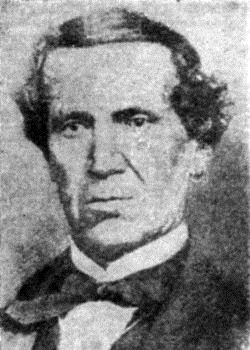
Manuel José Gómez Rufino was an Argentine politician who was governor of San Juan Province, Argentina between 1857 and 1858 and again between 1873 and 1874.

The Decembrist revolution was a military coup in the Buenos Aires Province, Argentina. Juan Lavalle, returning with the troops that fought in the Argentine-Brazilian War, mounted a coup on December 1, 1828, capturing and killing the governor Manuel Dorrego and ultimately closing the legislature. The rancher Juan Manuel de Rosas organized militias that fought against Lavalle and removed him from power, restoring the legislature. However, as the coup had reignited the Argentine Civil Wars, Rosas was appointed governor of the Buenos Aires province to wage the war against the Unitarian League. Both José María Paz, from Córdoba, and Rosas formed a league of provinces. The conflict ended soon after the unexpected capture of Paz, when he mistook enemy troops for his own.